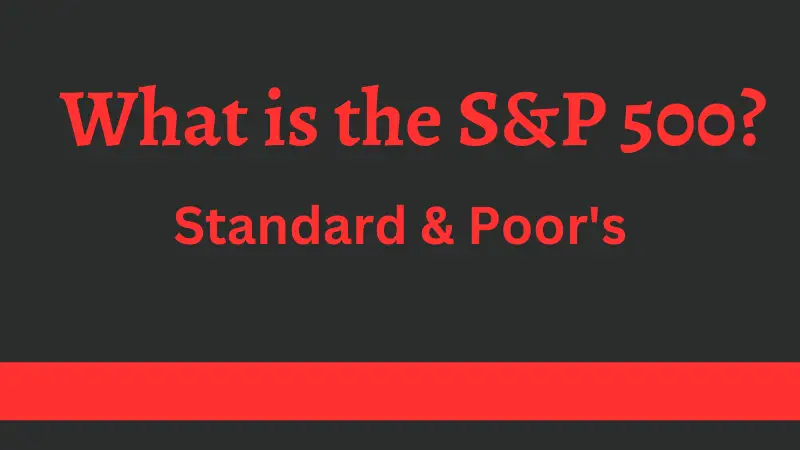What is the S&P 500?

What is the S&P 500? The S&P 500, or Standard & Poor’s 500, is a stock market index that measures the performance of 500 large publicly traded companies listed on U.S. stock exchanges. The companies included in the S&P 500 are selected based on various factors, including market capitalization, liquidity, and sector balance.
It differs from the Dow Jones Industrial Average (DJIA) or The Dow which tracks only 30 large publicly traded companies. The S&P 500 is widely regarded as one of the most important benchmarks of the U.S. stock market and is used as a gauge of the economy’s overall health. Many investors use the S&P 500 as a benchmark for their own portfolio performance or to track the performance of the stock market as a whole.
How Does the S&P 500 Work?
The S&P 500 is a stock market index used to track the performance of 500 of the largest publicly traded companies in the United States. The index is maintained by S&P Dow Jones Indices, which is a division of S&P Global.
The S&P 500 is a market capitalization-weighted index, which means that the companies with the largest market capitalization (the total value of their outstanding shares of stock) have the greatest impact on the index’s performance.
The index is calculated by taking the sum of the market capitalizations of all 500 companies in the index and dividing it by a divisor, which is adjusted to account for changes in the index’s composition, such as stock splits, mergers, and acquisitions.
The S&P 500 is widely considered to be a benchmark for the overall performance of the U.S. stock market and is used by investors and financial professionals to evaluate the performance of individual stocks and mutual funds, as well as to make investment decisions. Because it includes 500 large-cap companies from a variety of industries, the S&P 500 is seen as a good representation of the U.S. economy as a whole.
History of the S&P 500
The S&P 500, or Standard & Poor’s 500 Index, was first introduced on March 4, 1957, by Standard & Poor’s. It was created to provide a broad measure of the U.S. stock market, reflecting the performance of the 500 largest publicly traded companies in the country. Since its inception, the S&P 500 has become one of the most widely recognized benchmarks for the U.S. stock market.
The S&P 500 has undergone several changes over the years. The original index was based on the market capitalizations of 425 industrial, 25 rail, and 50 utility companies. However, in 1957, the rail companies were dropped, and the index became known as the S&P 500.
In the Following Years
The S&P 500 continued to evolve. In 1988, Standard & Poor’s created the S&P 100 Index, which is a subset of the S&P 500 made up of the largest and most established companies. In 1999, the S&P 500 was expanded to include 10 additional industry sectors, which led to the creation of the Global Industry Classification Standard (GICS).
Over the Years
The S&P 500 has experienced both ups and downs. It has gone through several significant market crashes, including the crash of 1987, the dot-com bubble of the late 1990s, and the financial crisis of 2008. However, it has also seen significant growth, with the S&P 500 reaching all-time highs in recent years.
Today
The S&P 500 remains a widely followed index, and it is used as a benchmark for the performance of the U.S. stock market. It is comprised of companies from a variety of industries, including technology, healthcare, financials, and energy, and it is considered to be a good representation of the U.S. economy as a whole.
Difference Between the S&P 500 and the Dow
The S&P 500 and the Dow Jones Industrial Average (often referred to simply as the “Dow”) are two of the most widely followed stock market indices in the United States. While they both provide a snapshot of the overall performance of the U.S. stock market, there are some key differences between the two:
- The S&P 500 is made up of 500 of the largest publicly traded companies in the United States, while the Dow is made up of only 30 large, blue-chip companies. The Dow’s components are selected by the editors of The Wall Street Journal, while the S&P 500 components are selected by a committee at S&P Dow Jones Indices.
- The S&P 500 is a market-cap-weighted index, meaning that the weight of each component is determined by its market capitalization (i.e., the total value of all outstanding shares of a company’s stock). The Dow, on the other hand, is a price-weighted index, meaning that the weight of each component is determined by its price per share.
- Because of their different compositions and weighting methodologies, the S&P 500 and the Dow can sometimes have different performance characteristics. For example, in years when large-cap stocks are outperforming small-cap stocks, the S&P 500 may perform better than the Dow, which is heavily weighted toward large-cap stocks.
Both the S&P 500 and the Dow can provide useful information about the overall health and performance of the U.S. stock market, but they each have their own unique characteristics and strengths.
How to Start Investing in the S&P 500?
There are several ways a person can start investing in the S&P 500. Here are some options:
Online Brokerage Accounts
Online brokerage accounts, such as Robinhood, E*TRADE, TD Ameritrade, or Charles Schwab, allow you to buy and sell stocks, mutual funds, and ETFs. You can set up an account, transfer funds, and start investing in the S&P 500 through a mutual fund, ETF, or individual stocks.
Robo-Advisors
Robo-advisors are automated investment platforms that use algorithms to create and manage your investment portfolio. Platforms such as Betterment or Wealthfront offer low-cost investment options that track the S&P 500.
Mutual Fund Companies
Some mutual funds companies, such as Vanguard, Fidelity, or BlackRock, offer S&P 500 index funds that you can invest in directly. You can set up an account and start investing in the fund, and the fund manager will handle the investments for you.
Financial Advisors
A financial advisor can help you determine the best approach for investing in the S&P 500 based on your investment goals, risk tolerance, and financial situation. They can help you create a diversified portfolio that includes S&P 500 investments, and monitor and adjust your portfolio as needed.
Regardless of the method you choose, it is essential to do your research and understand the risks associated with investing before making any decisions. Consider your investment goals, risk tolerance, and the fees associated with each investment option
The Importance of the S&P 500
Overall, with a market cap of $33.9 Trillion, the S&P 500 is an important component of the U.S. financial system and provides valuable insights to Investors and Financial Professionals into the health and performance of the stock market and the broader economy. It also provides a widely recognized and trusted benchmark for tracking trends and making investment decisions.


